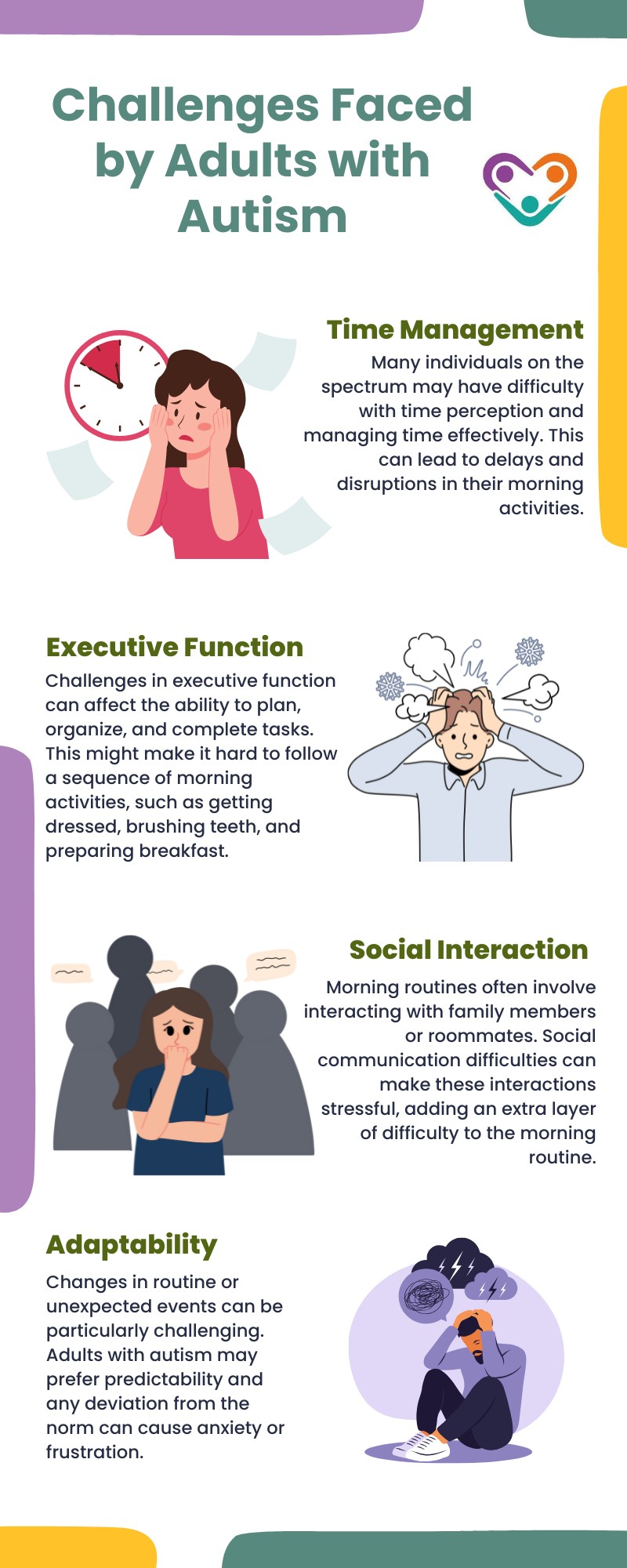For adults with autism, having a consistent morning routine can significantly impact their day-to-day life. Establishing a structured morning routine helps reduce anxiety, increase independence, and provide a sense of normalcy. Regular routines allow adults with autism to know what to expect, minimizing stress during transitions and helping them feel more secure and in control. Available support and programs can further enhance this sense of stability by providing resources tailored to their needs.
Individual Variations in Morning Routines
Each individual with autism is unique, and their morning routines may vary widely based on their personal preferences, sensory sensitivities, and the challenges they face. While one adult might need a slow, quiet start to the day, another might thrive with physical activity immediately upon waking.
Personalizing routines to fit individual needs can enhance the effectiveness of the morning schedule.
Understanding these variances and being flexible can help create a routine that caters to the specific requirements of each person, promoting a smoother and more enjoyable start to the day. By considering the importance of routine and recognizing individual preferences, caregivers and individuals with autism can work together to develop a morning schedule that optimizes daily functioning and overall well-being.
Understanding Autism and Morning Routines
Understanding the intricacies of morning routines can be particularly crucial for adults with autism. The start of the day can often set the tone and influence the rest of the day, making it essential to address the specific needs of individuals on the spectrum during these early hours.
Adults with autism often experience heightened sensory sensitivities that can significantly impact their morning routines. These sensitivities may include sensitivity to light, sound, touch, and even temperature.
For example, bright light from the sun or harsh overhead lighting can be overwhelming for some individuals. Similarly, noises from alarms, household appliances, or morning traffic can be distressing. Textures of clothing or grooming tools may also cause discomfort.
Recognizing and mitigating these sensory triggers can help create a more comfortable and manageable morning routine.
That said, adults with autism may face a variety of challenges when it comes to establishing a consistent morning routine. These challenges can be broadly categorized into different areas such as:

Identifying these challenges is crucial for caregivers and individuals to work towards creating strategies to address and overcome them, making mornings smoother and more efficient.
Components of a Morning Routine for Autistic Adults
Establishing a consistent morning routine can significantly benefit adults with autism by providing structure and managing anxiety. Here, we explore the key components of a morning routine which are as follows:
Waking Up and Transitioning
Waking up can be a challenging part of the morning for many adults with autism. It is crucial to create a smooth transition from sleep to wakefulness to set a positive tone for the day.
Personal Care and Hygiene
Personal care is a vital part of the morning routine and includes activities such as showering, brushing teeth, and getting dressed. These activities can be broken down into smaller, manageable steps to make them less overwhelming.
Meal Preparation and Breakfast
Having a nutritious breakfast is essential to start the day right. Meal preparation can be a time for learning and practicing independence, though it may require various levels of assistance.
Consistency in the components of a morning routine can aid in lowering stress and promoting independence for adults with autism. Each step, from waking up to having breakfast, contributes significantly to a well-structured start to the day.

How to Create a Structured Morning Routine
Creating a structured morning routine can significantly benefit adults with autism. These routines help reduce anxiety and increase independence by providing a clear framework for the day.
Visual schedules are critical tools for establishing an organized morning routine. They provide a visual representation of tasks, helping individuals understand and follow the sequence of activities. Visual schedules can include pictures, symbols, or written words, tailored to the individual’s preferences and comprehension level.
Timers are also helpful in managing time and maintaining structure. They can signal the beginning and end of activities, reducing uncertainty and aiding in transitions. Timers can be digital, analog, or even a simple alarm.
Also, breaking down tasks into smaller, manageable steps can make a morning routine less overwhelming. Simplifying instructions and providing clear, concise directions enhance comprehension and execution. Using step-by-step guides or checklists can be particularly effective.
Simplified tasks and clear instructions help build confidence and reduce stress.
Lastly, predictability and consistency are fundamental in creating an effective morning routine. Establishing a consistent order of activities provides a sense of security and helps individuals anticipate what comes next. This predictability can lower anxiety and improve engagement in morning tasks.
Consistency in timing is also beneficial. For example, waking up at the same time each day or eating breakfast at a fixed time can reinforce a stable routine.
Needless to say, creating a structured morning routine with visual schedules, simplified tasks, and predictability can greatly enhance the morning experience for adults with autism. These strategies provide stability, reduce anxiety, and foster independence.

Conclusion
.A strong morning routine can set the tone for a successful and stress-free day for adults with autism. It brings structure, reduces anxiety, and helps navigate the challenges of everyday life more easily. By incorporating calming activities and familiar steps, mornings become predictable and empowering.
Taking the time to create a morning routine that works, whether it’s through sensory-friendly environments, using visual aids, or allowing extra time to adjust, makes a significant difference in overall well-being.
Embracing a routine that works for each individual can promote confidence, independence, and a positive start to every day. At Golden Care Therapy, we understand the importance of tailored support and offer high-quality ABA therapy to help individuals thrive in their personal and academic lives.
Our experienced team is dedicated to providing compassionate, evidence-based therapy that empowers individuals to reach their full potential. If you’re looking for ABA therapy in New York, New Jersey, Indiana, Georgia, or Florida, don’t hesitate to contact us today.
Let us help you create a personalized plan that fosters growth and success!
Sources:



